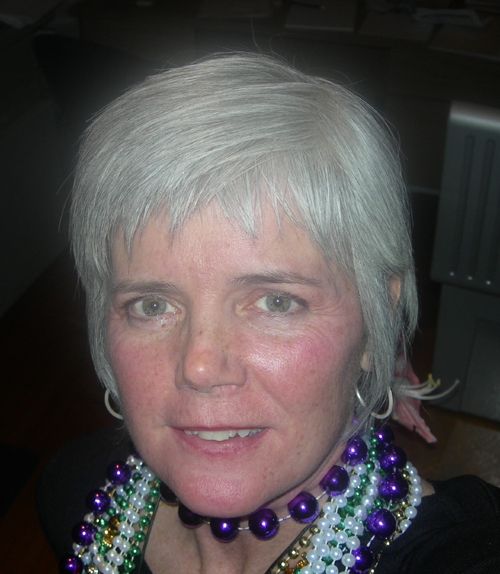Susan Hannah – Queen’s University
“Exploring the Spectrum, first the people, then the science”

As a mature student, I felt especially honored to be given the opportunity to work with Dr. Holden and Heidi Penning; both women had impressed me greatly with their dedication, compassion and drive to improve the lives of people diagnosed with autism spectrum disorders as well as their families.
Coming to work at Ongwanada, a facility supporting individuals with developmental disabilities and/or autism, the Monday following my last exam on Saturday exposed me to people who were all across the range in terms of this disorder, from low-functioning to high-functioning and everywhere in between. What I learned was that they were people just like me, with their own ideas, needs to be accepted and listened to – whatever their form of communication; delight in sharing their successes; and frustration at their own failures, but even more so with other people’s failures to give them a chance.
Over the course of the summer, I was able to see Jim, an adult with autism and Dr. Holden’s brother, develop a sense of responsibility towards caring for the family’s extensive gardens, taking a special delight in running the riding mower, and keeping the sidewalk edges tidy, as well as taking huge leaps of understanding in reading and writing. Jim continues to be a tremendous help at home, and is a tremendous source of pride to his mother and sister.
As well, during the summer, I pursued literature searches focusing on correlations between sleep and autism, and teratogens and autism, following the work of leaders in research. It was an eye-opening experience, I can understand now why there is an ongoing drive for people to devote their lives to a better understanding of autism with the hope of helping those on the spectrum. One of the tasks I was assigned was to examine ADI-R booklets, the tool used for interviewing families about the diagnosed child’s behavior and activities. While the interview was coded, and an assessment made, there was much more information to be gleaned from these booklets – notes taken by the interviewer about issues brought up by the parents. The main assignment given to me and another student, Anna, was to peruse the ADI-R booklets, seeking out common themes, and unusual events or behaviors that could lead to new research to identify and improve the lives of people on the spectrum. We compiled a list of possible survey questions based on interesting recurring statements we discovered, possible sources of genetic identification, or behaviours. These questions are now being assessed by a parent group who works with researcher group at ASD-CARC, with the idea of posting them online as a survey for families to complete.
I was also given training to input data into the online database from the ADI-R questionnaires, and another survey, a Prospective study, where families with one child diagnosed with an autism spectrum disorder, and having a younger child who was therefore at risk for developing an ASD, were participating in interviews designed to help in early detection and intervention in autism spectrum disorder. It was heartening to hear the stories about families in the study, who had early autism symptom detection leading to diagnosis at 12 months of age, and how intervention therapy had reduced the behaviors of autism to the point where their child no longer had the diagnosis.
One of areas where I gained a great deal of knowledge over the summer and one of the big success stories for ASD-CARC was the website (www.asdcarc.com) which has research questionnaires available for families to complete online at their own convenience. This dynamic website offers parents, people on the spectrum, friends, researchers, therapists, and interested parties opportunity to organize, with the Event Calendar posted, to learn through the posted journal papers by ASD-CARC researchers, to celebrate by posting pictures, stories, personal successes, or to connect through the discussion forum, a place to share parenting tips, therapy successes, and new questions, as well as opportunities for researchers to share their questions, surveys and findings. The generosity of families sharing their stories and information has led to a much better understanding of the spectrum. ASD-CARC aims to give back to the families by providing a community for them online, AutismConnects. This virtual community is a place where families can share their stories and celebrate their successes, give other families coping strategies and hope for tomorrow, where therapists in new neighborhoods can be found, and new friends are just waiting to be discovered.
Prior to my return to student life, my career had been in graphic design with a focus on publishing books, and I was pleased to bring this experience to the ASD-CARC position. During the past 6 months, I have worked closely with Dr. Jeanette Holden to create several projects: a brochure showcasing AutismConnects, 2 ads advertising the website—one for the Geneva Centre Symposium and the other in a fall edition of Autism Matters and this banner, which stands 81” tall. Jeanette and I envisioned this banner as celebrating how the AutismConnects virtual community offers a three-pronged approach for supporting families:
The banner at the beginning of the pathway, introduces the AutismConnects website banner, and represents the family members allied with a therapist/research figure, coming together to lead the way to understanding the mystery of Autism, making a difference to families along the way.
The winding pathway itself represents the endurance with which families, friends, and researchers face the many questions for causes, identification and support of people on the autism spectrum. We have highlighted here many of the special groups who are essential to the success of this community, as well as the features provided at the AutismConnects portal.
Finally, the AutismConnects Partners feature the ever-growing panel of support agencies associated with, and linking to the AutismConnects portal.
| SITE MAP STUDIES |
QUESTIONNAIRES
MY ACCOUNT
CONTACT US
| Q–GLO LOOKING FOR SOMETHING? |





